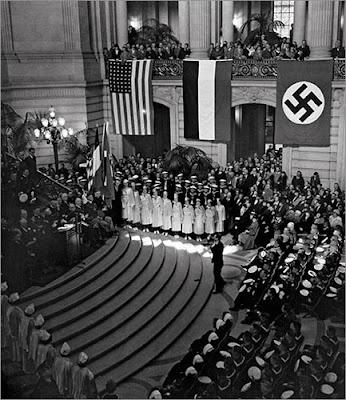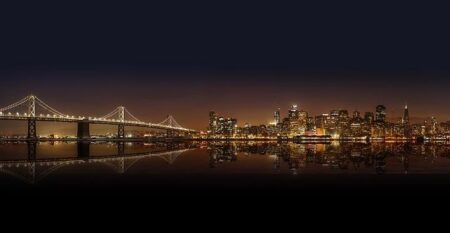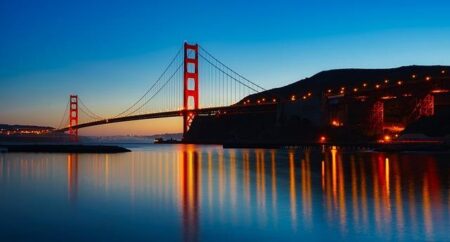Reexamining San Francisco’s Nazi Sympathizer History Through Modern Perspectives
Unveiling a Forgotten Chapter: Nazi Influence in San Francisco’s Past
During the World War II era, San Francisco harbored a lesser-known yet significant presence of Nazi sympathizers and propaganda efforts that infiltrated its social and political fabric. This often-overlooked facet of the city’s history reveals how foreign extremist ideologies once threatened the harmony of its diverse population. As contemporary media and scholarship revisit these events, they underscore the importance of vigilance in protecting democratic values from the resurgence of radical narratives. The Bay Area’s experience serves as a powerful reminder of how communities can resist and endure in the face of ideological threats.
In parallel, the popular Amazon Prime series The Man in the High Castle has reignited interest in alternate histories by depicting a United States under Axis domination. This fictional scenario resonates deeply with San Francisco’s historical realities, prompting reflection on themes of power, resistance, and identity. The table below contrasts key historical elements with their dramatized counterparts and modern-day implications:
| Historical Context | Fictional Representation | Contemporary Significance |
|---|---|---|
| Bay Area Nazi sympathizers and propaganda cells | Pacific States under Japanese and Nazi control | Heightened awareness of extremist ideologies |
| Media used to disseminate propaganda | Strict censorship and information control | Emphasis on media literacy and critical thinking |
| Local resistance movements | Underground rebel factions | Recognition of grassroots activism’s role |
Engaging with San Francisco’s complex past alongside contemporary cultural works encourages a nuanced understanding of how history informs present-day democratic resilience and the ongoing fight against authoritarianism.
The Man in the High Castle: A Thought-Provoking Exploration of Alternate Realities
Philip K. Dick’s seminal novel and its television adaptation, The Man in the High Castle, present a haunting vision of a world where the Axis powers triumphed in World War II, fracturing the United States into occupied territories. This speculative narrative challenges audiences to contemplate the fragility of historical outcomes and the profound consequences of authoritarian rule. By dramatizing a reality dominated by propaganda and oppression, the series invites reflection on the enduring impact of ideology and cultural memory.
Several aspects contribute to the series’ compelling portrayal:
- Multifaceted Characters: Individuals navigating loyalty, rebellion, and survival under totalitarian regimes.
- Intricate Political Landscape: Tensions among the Nazi-controlled East Coast, Japanese Pacific States, and neutral zones create a dynamic backdrop.
- Symbolic Storytelling: The use of forbidden films within the plot serves as a metaphor for truth and resistance.
| Element | Historical Reality | Alternate History Depiction |
|---|---|---|
| World War II Outcome | Victory for Allied forces | Axis powers emerge victorious |
| National Unity | United States as a single nation | Divided territories under foreign occupation |
| Cultural Climate | Democratic freedoms and civil liberties | Authoritarian control and pervasive propaganda |
Local Legacies: The Enduring Effects of Nazi Ideology in San Francisco
While the global consequences of Nazi ideology are extensively chronicled, its subtle yet persistent influence on local communities like San Francisco warrants closer examination. The Bay Area’s urban development, cultural institutions, and social dynamics bear traces of this troubling legacy, often hidden beneath the city’s progressive image. Recognizing these undercurrents is essential for understanding how extremist ideas can embed themselves within communities and persist across generations.
Notable manifestations of this legacy include:
- Urban Planning: Certain neighborhoods were originally designed with exclusionary principles reflecting segregationist attitudes.
- Historical Organizations: Archival evidence reveals early 20th-century groups with sympathies toward authoritarian nationalism.
- Artistic and Media Responses: Post-war cultural productions have variably confronted or obscured these dark influences.
| Category | Local Manifestation | Current Relevance |
|---|---|---|
| Architecture | Structures exhibiting fascist-era design elements | Preserved as historical sites with critical contextualization |
| Street Names | Named after controversial historical figures or events | Ongoing community debates about renaming for inclusivity |
| Public Discourse | Historically limited discussion on ideological legacies | Growing educational initiatives and open forums |
Fostering Critical Conversations and Education on Authoritarian Histories
Addressing the legacies of authoritarianism requires more than recounting historical facts; it necessitates cultivating spaces for critical dialogue and comprehensive education. Acknowledging uncomfortable truths—such as the existence of Nazi sympathizers in San Francisco—helps communities understand the long-term social ramifications and strengthens democratic resilience. Engaging with cultural works like The Man in the High Castle encourages audiences to explore “what if” scenarios, deepening awareness of ideological extremism’s dangers.
Strategies to promote informed understanding include:
- Inclusive Discussions: Ensuring diverse voices and perspectives are heard to enrich dialogue.
- Accessible Educational Materials: Connecting historical events to current societal challenges.
- Community Engagement: Hosting seminars, panels, and screenings that invite active participation.
- Partnerships with Experts: Collaborating with historians and educators to ground conversations in rigorous research.
Looking Ahead: Embracing History to Safeguard Democracy
As public discourse around history and representation evolves, revisiting San Francisco’s encounters with Nazi ideology underscores the enduring importance of confronting difficult pasts. Coupled with the provocative themes explored in The Man in the High Castle, these reflections offer valuable insights into how alternative histories can illuminate contemporary challenges. By facing uncomfortable realities and critically engaging with media portrayals, San Francisco’s community can foster a deeper understanding of history’s complexities and reinforce vigilance against intolerance and authoritarianism.




